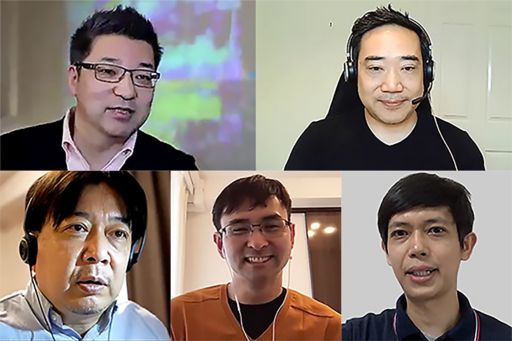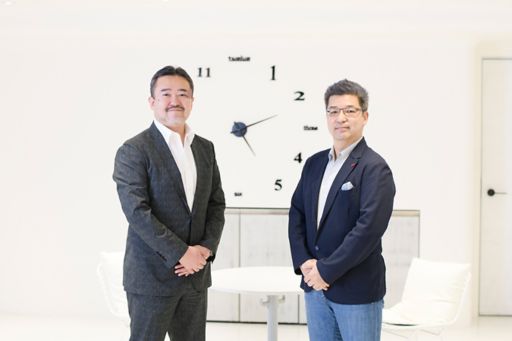It is not easy for a company to maintain its existing business and at the same time take on new challenges while ascertaining social trends. This is especially true when its existing business is “doing well.” What kind of thinking and elements are necessary for a company to pursue the essence of its own business and renew the very nature of the company itself?
We will introduce some discussions conducted on this issue between Masayuki Chatani of KPMG Ignition Tokyo and Kohei Terada, President & CEO of Warehouse TERRADA.
Contents
- Link to Vol. 1
- Isn’t There Any Friction within the Organization when Introducing Digitalization?
- Reason Why Community-based Company Can Take on Challenges Unconstrained by Existing Business
- Digitalization, Curiosity and Imagination Will Expand Business Possibilities
- What to Aim for after Expanding Business Possibilities with Digitalization
- Profile of Interviewee
Isn’t There Any Friction within the Organization when Introducing Digitalization?
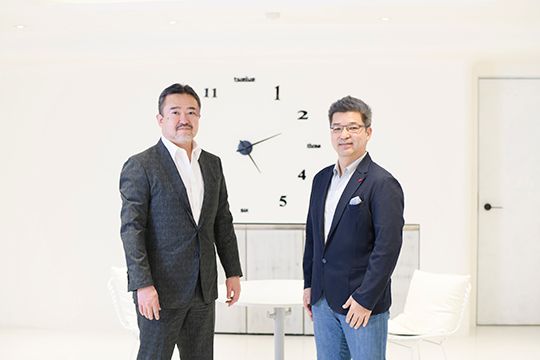
(Kohei Terada, President & CEO of Warehouse TERRADA (left), Masayuki Chatani, Representative Director & CEO of KPMG Ignition Tokyo and CDO of KPMG Japan (right)) *Professional affiliation and official position in the article are at the time of publication.
Chatani: When digitalizing various things or introducing digital technology in business, we often hear that there is friction within companies. How was it at Warehouse TERRADA?
Terada: Well, I used to be in the IT industry and the previous CEO, who was already over 70 years old, was very strongly interested in new things such as digital technology. My father, who was the CEO before him, was also one of many who were very interested in digital technology.
All the management team agreed to move toward digitalization without any argument and we were also employing personnel who were in favor of digital technology in the process of continuously changing services. This is how we spontaneously shifted to digitalization.
However there are also difficulties in increasing the number of engineers and our current workforce consist of about 40 engineers among some 130 employees and contract workers combined.
Reason Why Community-based Company Can Take on Challenges Unconstrained by Existing Business
Chatani: Warehouse TERRADA is not just storing wine and art but is also taking on challenges that are unconstrained by its existing business, for example, creating a riverside atmosphere including a café. What kind of internal discussions do these ideas come from?
Terada: I think it all comes down to “what the core of our business is.” It used to be real estate and storage, and the revenue model that combines these two forms the backbone of our business. From that perspective, it is no exaggeration to say that what we are doing now is just one thing.
First of all, we asked ourselves, “How can we maximize the value of the space?” In pursuit of this question, we came up with a model of providing storage and related services for goods with high unit costs, while at the same time revitalizing the entire town by adding the feature of design to the space. In other words, we took into account both the top niche storage business and the community development.
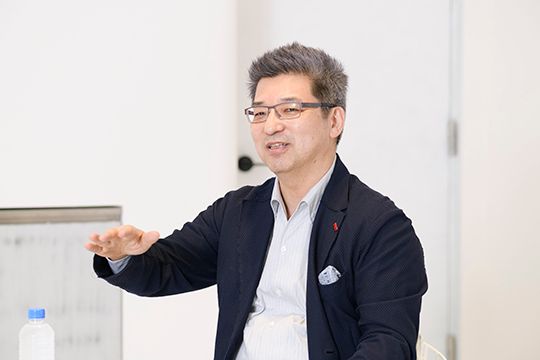
Chatani: I have been to the restaurant “T.Y.HARBOR” in Tennoz. Is your company operating a restaurant business as well?
Terada: In fact, the restaurant business is an exception. My younger brother started a company and is taking on this business. He is therefore our tenant. Meanwhile, as he is part of our family, we are promoting the project together by discussing “what elements are necessary for this town.”
During the so-called bubble economy, Tennoz was overrun with office buildings, giving the impression that Marunouchi or Otemachi had suddenly appeared in Tennoz. There are more residential buildings now, but when there are only many offices, commercial tenants such as restaurants and other facilities that attract people will only be in demand during the lunch hours on weekdays and so there will be only a few people on weekends.
Having been operating businesses based in Tennoz for many years, we looked at how the town was 15-20 years ago and thought that revitalizing the entire town was how we were going to survive. Therefore, around ten years ago we started to focus on building a town where there are always people around.
There are two ways to create content and revitalize a town. By coincidence, one of them was based on the keyword used when the town was developed during the bubble economy. From there, we started to redevelop the town based on the concept of “An Island of Art, a City with Heart, TENNOZ ISLE.” As we had long been storing works of art, it was natural for us to start thinking of revitalizing the town based on art.
We went beyond just turning real estate into offices and showrooms with stylish design and bringing in tenants. We aimed to revitalize the entire town by creating warehouse spaces that could also be used for high-quality events and facilities that could disseminate art and culture. We created an environment where people could buy works of art by coming here such as the “TERRADA ART COMPLEX,” the largest gallery complex in Japan occupied by galleries representing Japan, and “WHAT CAFÉ," which exhibits more than 100 different works of young artists every month and sells them. This also goes for Art Café but you can probably say that we are trying to provide services that boost the entire art industry in various forms based in Tennoz rather than using art to develop the town.
As a result of combining these individual elements, people start to visit the town spontaneously, which revitalizes the entire business and enhances the attractiveness of the town as a whole. We expect that the measures to attract tenants will then change gradually. We are thinking of gradually expanding the network of revitalization from Tennoz to nearby areas. This is why we have now started to earnestly study its upstream and digital technologies.
Digitalization, Curiosity and Imagination Will Expand Business Possibilities

Chatani: The world of art is also going through major changes with the introduction of blockchain technology in recent years. Is there any field you are interested in further challenging using digital technology going forward?
Terada: Well, it is obvious that there will be elements that will grow going forward using new technologies such as NFT (non-fungible token) and I look forward to that.
On the other hand, however, I believe that the power of analogue such as the power we feel when we see a real work of art will bring priceless value in our lifestyle.
Nevertheless, the gallery complex, which is considered to be very large, is actually not so large and the entire industry is growing little by little with the great efforts of individual galleries. It has been claimed that the possibilities in Japan have not been maximized compared to western countries. This is because mega galleries have been established in western countries and there are schemes with overwhelmingly efficient operations and global marketing that enable artists to spread their wings around the world.
Compared to this, a very analogue world view still remains in Japan. We hope to provide a platform where these people can carry out marketing and suddenly grow. Our initiative to store works of art in an optimum environment and promote digitalization will contribute to creating a world that will digitally expand art.
Another challenge I want to undertake, which is something I am personally interested in the most, is to “visualize people’s preferences.” In fact, we are now carrying out experiments in various forms. In the first phase, we were discussing this with the executives of data mining companies. However, we then realized that we had no other choice but to conduct research based on “how we can tag art.” We are therefore frequently communicating with cultural anthropologists and psychologists now.
This challenge is in line with the theme of how we can realize a system that can search for the art of one’s preference by using digital technology within a budget. However, it is difficult to visualize something that cannot be seen, as was expected.
Chatani: There used to be an engine called music serendipity on the “PlayStation Portable (PSP)” which disassembles the characteristics of music content and prompts an approach to make music that is closer and similar to those characteristics. Though we created such a scheme, it was difficult to match it with people. Because of this experience, I feel it is extremely important to tag the preferences of people.
Terada: I see. I believe that visual information like art is the easiest type of information to process with AI but I am aware that people’s preferences are quite difficult.
Chatani: That’s because the preferences of people are inconsistent.
Terada: Quite so. However, roughly speaking, I think that our final goal will probably be to tag both the world view of classifying things and the world view of classifying people, and then match these two.
Chatani: Are you conducting these initiatives through business-academic collaboration?
Terada: Regarding business-academic collaboration, we are working based on a somewhat private relationship by asking someone to help us when we “think this person can realize this.” We are now promoting the project steadily but if we can start focusing based on the viewpoint of “visualizing people’s preferences” as I am doing, I think there will be more areas for experimentation and research.
I imagine that the visualization of people’s preferences can be applied not just to encountering art but also to other genres such as fashion and interior design. This can be considered different from a conventional recommendation engine.
I think that the evolution of recommendation features is very important in the world of marketing but the major objective of what I am doing now is rather the personalization of each individual. What is important is how much we can flag individual personalities and I think that one of the experiments is to visualize people’s preferences.
Chatani: In a way, it is especially difficult to search for works of art represented overseas.
Terada: Not all works of art exist as data and it is extremely difficult to search for them with words. This is why we are promptly digitalizing what we are storing for customers at our cost.
Chatani: It is certainly becoming easier to create learning data, as the Metropolitan museum has also started to digitalize all their collections in recent years.
Terada: That’s right. The Louvre is also digitalizing the works of art they possess, so we are hoping to utilize these data in an experiment to see what kinds of “answers” we can come up with from these data.
Chatani: It may then be possible to create a work of art that suits one’s preference, like court painters in the old times.
Terada: Yes. Talking about art a little more in-depth, it is said that only 3% of artists in Japan are working as professional artists and earning a living only through art. This can’t be helped due to the commercial structure in Japan.
Artists can only create 50 to 100 works at their very best and can only sell them at 50,000 – 100,000 yen per work. Moreover, considering the commissions charged by the galleries when they are sold, they will have to live on about 2-4 million yen.
Chatani: That will put them in an extremely tough situation. It is almost impossible for them to make a living.
Terada: That’s right. On the other hand, assuming that they can sell more than 50 works of art per year at around 100,000 to 150,000 yen per piece, that will be sufficient for them to live on. To put it more simply, what we have to do is to create about 100 people per artist who “want the artist to draw or create works” and drive market prices higher.
If we are going to purchase a work of art that costs from over 1 million to 10 million yen, we will be worried how it is appraised by professionals or in the world. However, I think we can decide to purchase works of art that cost from 200,000 to 300,000 yen based on our likes and dislikes. Of course, it would be great if the work of the artist you purchased went up in price afterward.
I expect that this world view can be created by thinking in a CGM (Consumer Generated Media) way. This is why we are providing full support so that the share of artists “who can live on art,” which is said to be 3% now, will become 10% and that the market will spontaneously expand. We are also trying to create an environment where artists can “make a living on art” as a base. I imagine that this will create the time and money for “the challenge of the new,” which is the starting point of modern art, and the possibility of mutant art being born out of it.
Chatani: The importance of artistic thinking has become important recently and there are things I am keenly aware of. I understand that it is important to foster the art market in this way.
Terada: When it comes to this, education is the starting point. One of the big differences in educational opportunities related to art between Japan and western countries is the presence of “appreciation” education. In Japan, we are instructed to “copy” or “draw” art and this way of thinking is the basic idea of art education.
In western countries, however, appreciation is the foundation of art learning. By practicing this, the ability to appreciate art and an artistic sense can be developed spontaneously.
So, we too wondered, “How can we establish an educational platform?” and we launched projects such as inviting nearby elementary school students to Warehouse TERRADA’s museum. These activities are absolutely necessary and we plan to encourage these activities including in relation to the government.
Chatani: I do not dare to call myself an artist but I am releasing one calligraphy work a year in the calligraphy exhibition held at the National Art Center. For the first seven years, I used to exhibit calligraphies I copied from classic works but I have been writing letters that I decided myself for the past four years and I find myself enjoying writing creative letters more. I feel that creativity is the basis of art and that it is very important to create works of art that you really like.
Terada: That probably means that we should respect our inspiration.
What to Aim for after Expanding Business Possibilities with Digitalization
Chatani: You talked to us about the transition Warehouse TERRADA has gone through and its essence but what do you think Warehouse TERRADA’s future will be like in 50 and 100 years from now?
Terada: We have been promoting all our past initiatives based on the multiplication concept. After we establish some kind of a system in Tennoz, we would like to develop a community somewhere distant from Tennoz next. We will be able to revitalize the community by using necessary elements such as methods of decorating art, battles using art, or other content. It will also be possible to create spaces by combining art and design.
If possible, we would like to create “something” that coexists with local communities, rather than establishing a sightseeing base, in a distant regional location. Community development, reusing what exists now and making it better, has actually started in three locations.
Chatani: What is the biggest obstacle in doing this?
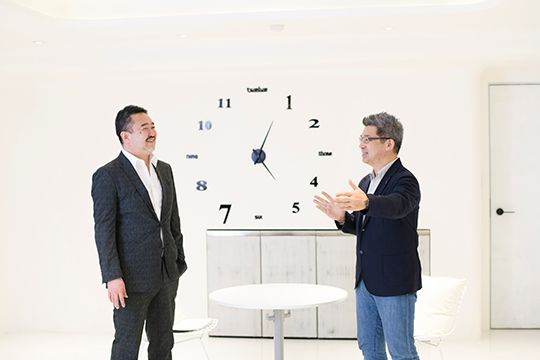
Terada: That’s difficult to answer but I guess it’s the mindset of the decision makers. Even if a lot of tourists can be attracted with appealing content, it is important to examine how it will benefit the entire town in the medium to long term. It is necessary to actually imagine that it may, on the contrary, become a concentrated shopping area and that the profits generated from there will not go to the community but to major companies.
While examination committees usually consist of many school teachers and accountants, I am sometimes concerned whether they are really thinking about the area or region. Though it is considered that “examinations should preferably be done by a third party,” the question of how to select a third party always comes up when we have discussions with various people who are working hard to revitalize local regions.
Chatani: From the perspective of an auditing firm, the correctness of such a method of selection may become the subject of auditing in the future.
Terada: I think so too. Will the system really benefit the local community in the medium to long term? For instance, a company I know thinks about coexisting with the local community when they are expanding their operations in local regions, and when they build their own sales space, they always give back to the local community by using about a third of the space to sell local products.
I hope this type of development, which benefits local people, will be promoted more but even now, there are talks about constructing a new building and operating a big shopping center. As the only benefit this will provide to the community is employment, I think this kind of development should be avoided.
On the other hand, I think that the government and the administration should, in some ways, abandon the sense of “saving everything.” What I’m trying to say is that unless they clarify what they need to save and provide full support for that, it will be difficult to save anything.
This is why I think that the current regional revitalization efforts are a little off target and that the trend to eliminate opposition, including political methods, is a factor in losing momentum. In this sense, though this is a macro perspective, there is a need to redefine the word democracy and reconsider what democracy really is.
Chatani: When we change the way we do business, various issues become visible and the themes we are going to tackle expand further. Lastly, can you tell us how you are creating these new perspectives?
Terada: I believe that any company or any service can always find better solutions if they desperately rack their brains.
As long as we can continue to pursue something that can “further fulfil the needs of customers even though we do not have it now,” even an “analogue company” like us is able to take on challenges. I therefore think that top management should have this kind of perspective.
Projects are often devised by top management but to continue to allow employees to take on new challenges, management must have the sense and ability to stay ahead of the employees who come up with those new challenges. I think that this sense and ability will eventually be passed on as a philosophy of a company, become a mechanism to nurture people to discover new things and ultimately make the company sustainable in society.
In the case of Warehouse TERRADA, I am the one who provides ideas but we repeatedly discuss what we must do to realize them like throwing a ball back and forth until we can achieve the final shape. In doing so, everyone needs to have the ability and sense to catch the ball and I think that the passion “to always try to create something new” is really important in these discussions.
Profile of Interviewee

Kohei Terada
President & CEO of Warehouse TERRADA
Kohei Terada joined Mitsubishi Corporation in 1993 after graduating from Keio University with a B.A. in law. He established Bit-isle Inc., a data center operating company, and became President in 2000. The company was listed on the Hercules Market of the Osaka Securities Exchange (currently JASDAQ Standard Market) in 2006 and the First Section of the Tokyo Stock Exchange in July 2013. After receiving a tender offer from U.S.-based Equinix Inc., the world’s leading data center company, Bit-isle was delisted in 2015 and Kohei Terada became COO & Director of Equinix Japan K.K.
In June 2018, he became President & Director of his family’s business, Warehouse TERRADA, and has served as President & CEO since June 2019. He is concurrently Chairman of the Japan Association of Corporate Executives and CO-WELL Co., Ltd., a leading offshore business in Vietnam, and an outside director at eBOOK Initiative Japan Co., Ltd. and MarketEnterprise Co., Ltd. As his personal investment destinations, he is also concurrently an advisor for various venture businesses including Mobcast Holdings Inc. and Allied Architects, Inc.
Follow us on KPMG Ignition Tokyo LinkedIn for the latest news.
Connect with us
- Find office locations kpmg.findOfficeLocations
- kpmg.emailUs
- Social media @ KPMG kpmg.socialMedia



